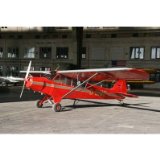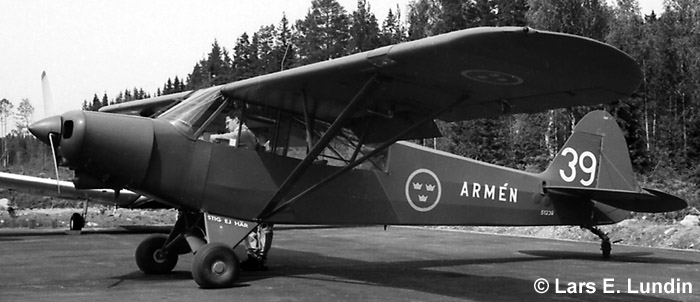|
|
||
| Fpl 51 - Piper PA-18 Super Cub (1958-1974) | ||
|
|
Page 1(2) |
|
|
|
||
 |
||
|
Everybody
has some time heard the name ”Piper Cub”. But it is perhaps not
commonly known that this is the name of eleven separately certified
models of aircraft. To be exactly correct, the name of the first ones
were ”Taylor Cub”. The models, including the ”Super Cub” were
powered by engines in the range from 37 to 150 hp. The tiny sport plane
was developed into a hard-working jack-of-all-trades.
The
brothers Clarence Gilbert (”CG”) and Gordon A. Taylor went into the
aircraft manufacturing business in the 1920s. When they moved from New
York to Pennsylvania, William T. Piper, a veteran of the
Spanish-American war, became a joint owner.
Piper
stated that the company needed a cheap, bare-minimum trainer design. It
would be two-seater and have a low power engine. C.G.Taylor agreed and
started the design work. In fact, this was one of the few things that
these disparate persons ever agreed on during their seven years of
co-operation. But aircraft did not sell well in this early Depression
year of 1930. After a bankruptcy, Piper took the financial control of
the firm, now with the name Taylor Aircraft Company. The name ”Piper
Aircraft Corporation” was introduced in 1937 when the enterprise had
moved to Lock Haven, Pennsylvania after a fire in the old factory.
The
design work resulted in a small tandem-seat aircraft with a wood-frame
wing with built-up metal ribs. The fuselage and the tail were designed
of welded steel tubes. The parasol wing was so close to the fuselage so
the persons in the open cockpit could not get into it by climbing over
the side. To solve this problem, a long single hinged hatch, was
installed on the right side of the fuselage to span both seats. It was
opened downwards. This became the standard design of all the tandem-seat
Cub models to follow.
The
first Cub in serial production was the E-2. It was powered by an engine
of 37 hp. But of the eleven of the Cub models that were certified by the
authorities - the J-3 variant - became built in 1937-1942 - the most
famous one. The company now carried the name Piper Aircraft Corporation.
The J-3 was a simple kind of aircraft. Among other things it lacked an
electrical system and wheel brakes. But in the WWII, the days of glory
for the Cub began. Between 5.000-6.000 aircraft were built for the
military - most of the J-3
variant (US military designation L-4).
It was flown in action for the first time in 1943 during the Allied
landings in North Africa. Its main duties were liaison, artillery
spotting and reconnaissance.
After
the war a large number of aircraft were sold on the surplus market. The
legendary aviator Albin Ahrenberg became during the war years leader of
the organization that took care of foreign aircraft which had made
emergency landings or of other reasons remained in Swedish territory.
When the war ended, Ahernberg took up his civil career again and, among
other things, used his good relations with the USAAF to get import
license for about 90
Piper Cub aircraft from American depots in Germany. These aeroplanes
were overhauled in Sweden and sold to private owners. After some years,
Göthe Johansson took over the sales of Piper aircraft in Scandinavia. As
a result to Johansson’s assiduous work, Scandinavia was the only place
in the World that Piper sold better than its closest competitor Cessna.
The
Swedish military aviation tested the L-4 for artillery observation, but
found it insufficient in the Swedish conditions. The engine was not
powerful enough and in winter time the snow whirled into the draughty
windows.
The
variant PA-18-150 - USAAF
designation L-21 - was a more
advanced design that suited the Swedish demands better. This ”Super
Cub” was powered by a much more powerful engine - the Lycoming
0-320-A2B of 150 hp and had a more spacious cabin. The STOL performance
was improved upon as the aircraft now was fitted with flaps.
In
Sweden, the Army now planned that a suitable number of private owned
Super Cubs would be mobilized in a war situation. But the fleet of Super
Cubs in Sweden was not large enough. In 1957, the Army decided to order
twelve Super Cubs - an order which later was enlarged. The first batch
of six PA-18-150 was designated Fpl
51A in Sweden and was delivered in 1958. The individuals got the
military numbers 51257-51262 but carried also civil registrations. When
not used by the Army, the aircraft were to be used as agriculture
sprayers by AB Jordbruksflyg, fitted with removable spray booms and
chemical tanks. During the first years the aircraft were painted red and
white.
The
second batch of six PA-18-150, now modified for military use, arrived in
Sweden in 1959 and got the designation Fpl 51B. One of the advantages was the improved all around view.
Individual numbers were 51251-51256. In 1963 a third batch of
six Fpl 51B was delivered (51245-51250). These aircraft would
replace and also complete the remaining Fpl 51A which now were sold to
civil flying clubs. A last batch of eleven Fpl 51B (51234-51244) were
delivered in 1964.
The
Super Cub was regarded as very dependable and suitable under rough
conditions. Some spares and tools were always carried in the aircraft.
The engine was easily and quickly to replaced. Minor reparations of the
fabric covering could be made by the own mechanics. In wintertime, skis
could be fitted. Floats could be fitted, but were never used in Sweden.
Totally
six Fpl 51A and twenty-three Fpl
51B were flown by the Swedish defence forces.
Photo
at top:
Fpl 51B # 51256, now hanging under the ceiling at Flygvapenmuseum.
C/n 18-6803, manufactured in 1959. After its active service in the Army,
it was civil registered as SE-GCI and used as a sailplane tug at Ålleberg.
Length:
6,8 m. Span: 10,7 m. MTOW: 795 kg. Max. speed: 240 km/h. |
||
|
For the
Model Builder |
||
The well-know British webshop Amazon.co.uk sells this model from Revell. The price is very favourable. Click on the thumbnail to get to Amazon's page for this model.
|
 |
|
 |
||
|
|
||
|
|
||
|
|
||
|
|
||
|
© Lars Henriksson |
Updated 2010-07-14 | |
|
Custom Search
|
||
